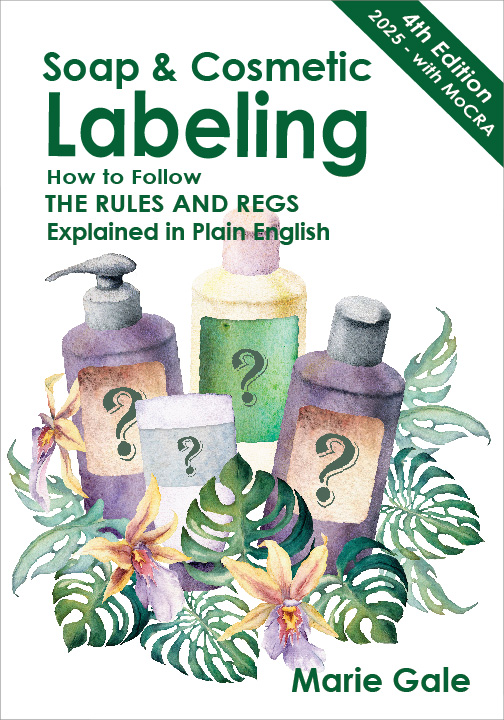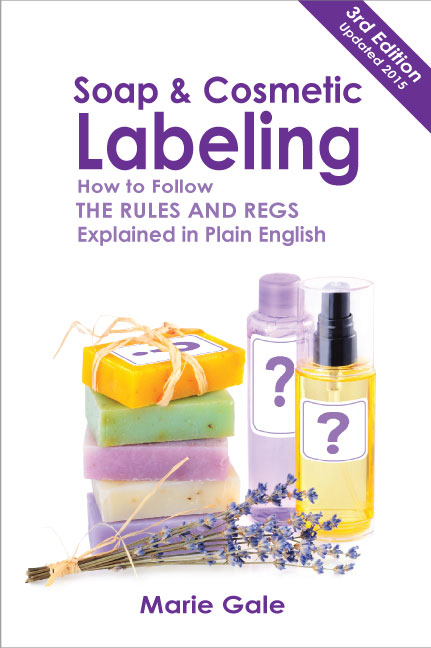I have to say I am just tickled with the review that Beth Byrne wrote about my book in the on-line soapmakers magazine, The Saponifier. When they said they were going to review the book I was happy, but I never expected such a glowing (and long) discussion of the book!
I’ve always been a fan of the The Saponifier. I subscribed to the print version way back when (that was when I first started soaping) and loved getting it. It was a sad thing when it was discontinued for a while.
But now it’s back! Kathy Tarbox, Beth Byrne (and no doubt others) are doing a bang-up job on getting a very professional e-mag delivered bi-monthly. It’s a real asset to the soapmaking community.
The review of my book was published in the September 2007 issue of The Saponifier, an e-Magazine for the soap making community.
Here’s the entire article, reprinted in full with permission of the publishers.
A New Treasure for Cosmetic Makers, and Others, Too!
How many times have you thrown your hands up in frustration after your efforts to decipher a portion of the United States’ FDA cosmetic labeling regulations? How much time have you spent looking for the portion that pertains to your situation? Worse yet, how many of you have yet to actually read and follow the regulations, due to their complicated nature? How many of you have never read your state’s regulations? What- you didn’t know your state had regulations? What additional requirements does your county have? You didn’t know there might be any? If you can identify with any of these questions, you owe it to yourself and your business to read Marie Gale’s new book, Soap & Cosmetic Labeling: How to Follow the Rules and Regs Explained in Plain English.
Marie’s book is exactly what the title leads you to believe it will be. It explains, in a reasonable format and in reasonable language, what the FDA demands of cosmetic manufacturers, large and small. Our federal government operates on the principle, at least where cosmetics are concerned, that the cosmetic maker will manufacture a safe product and play by the federal rules. According to Marie, this is a good thing for us, as it means we are not required by the government to submit our formulas for review before we are allowed to sell them. This is much more convenient for us, and avoids a lot of red tape; however, it places the onus of responsibility on the manufacturer to strictly and ethically follow the rules. Indeed, ours is a burgeoning industry and will garner more attention from the feds as it grows, so it behooves us all to carefully make and test our products, as well as to label them according to the regulations, both federal and state. If we do not, we will essentially force the government to institute more burdensome requirements in order to keep the marketplace safe for purchasers of cosmetics. Granted, correct labeling is difficult, especially for very small businesses where one person wears the all the hats, but it is essential, just the same.
In actuality, this book covers more than cosmetics; it is also helpful for labeling candles and other products that we often make and sell. It will tell you what information must appear on the label, where to put it, and even what size font to use. Certain basic content is required on virtually any label, and Marie includes this in the beginning of the book. Requirements for food and drug products are not included, however, along with items that are under the direction of the EPA.
Soap and Cosmetic Labeling begins by describing the FLPA, the Fair Packaging and Labeling Act, the Federal Trade Commission, the Federal Food, Drug & Cosmetic Act, and Uniform Laws – Weights and Measures. Knowing we have to satisfy all of these entities alone might convince anyone who wasn’t already certain that we likely need help in labeling our products; but it doesn’t end with the federal government. The book goes on to include each state’s listings of additional requirements, and where to find the documentation. For instance, under my state of New York, I discovered that the requirements are closely aligned with the federal requirements and that any additional information I would need could be found on a website given in the book. As if all of this wasn’t enough, the book discusses the need to research any requirements placed on our goods by our counties.
In her book, Marie subsequently describes just what is a cosmetic and what isn’t, giving you tips on how to determine which product you have, and thus, how to label it correctly. If, for example, you are producing a Consumer Commodity (such as candles, linen sprays, or potpourri) it is not a cosmetic and does not have to be labeled the same way as cosmetics. Surprisingly, certain cosmetics are considered to be Consumer Commodities and thus, subject to those labeling requirements rather than the cosmetic requirements.
Furthermore, Marie explains labeling definitions for packaging, with very detailed descriptions of the containers that must be labeled, the information required on each display panel, calculating the size of the panel, and in turn, what size label to put on it, and finally, what to do in labeling very small panels.
The FDA’s goal in labeling rules is that the average consumer is able to read and understand the label so that she knows just what she is purchasing, and the requirements that we must follow are to accomplish that goal. Rules include labels that fit the size of the container, contrast for easy reading, warning statements when required, type size, and ingredient listing requirements. Nevertheless, the explanations don’t stop there. The business address, quantity, multiple packaging regulations, and so on, are included as well.
Marie goes into detail regarding the misunderstandings of the ingredient list vs. the reality of what must be included and how to word it. In fact, did you know that there are exceptions to the rule that all cosmetics must have their ingredients listed? Other often misunderstood facets of ingredient listing are addressed, in addition to what is required. Sometimes, there are exceptions to the “descending order of prominence” rule, for example, as well as the notion that the ingredient list must go on the actual container. You’d likely to be surprised, as I was, at both the requirements and the exceptions noted.
As mentioned previously, the FDA has regulations regarding combined ingredient lists for packages with multiple products, and an entire chapter is devoted to these, as is a chapter describing special circumstances in regards to ingredient listing. Color matching and alternative ingredients are included, as are incidental ingredients, direct mail regulations and more.
Even if you believe you completely understood the safety warnings to include on your products, you may want to take a closer look. Not all cosmetics require a safety warning at all, and the book describes what does or doesn’t, and why. Additionally, rules are included for foaming detergent bath products, products for children, tanning products, aerosols, feminine deodorant sprays, and so on.
Label claims are also discussed, including “organic,” “made in the USA,” “Edible,” and environmental claims (such as those for organic, biodegradable, non-toxic, and recyclable labels on products). In fact, did you know that if you use the term, “introductory offer,” you have a list of requirements to fulfill in order to do so?
The last two chapters have to do with color additives in cosmetics, and discuss which ones we can use, which are certified, and which ones are not. Content includes where on the body they can be used, and special cases of products with requirements that were not previously discussed, including oral hygiene and vaginal products, animal grooming products, aromatherapy products, sunscreens, and private label products.
Fortunately for purchasers of this book, Marie has included appendices of color additives, INCI names, prohibited and restricted ingredients, and a handy metric conversion chart. She also includes a glossary and a convenient index that will be extremely helpful in locating exactly the information one is interested in.
What hasn’t Marie thought of? Actual correct labels as examples would be nice, but her descriptions and explanations are sufficient. The detail she goes into leaves one with the confidence that correct labeling is possible and maybe even less painful than previously thought. Admittedly, this book is not as absorbing as an afternoon curled up with an intriguing novel would be, but it is clearly written, thorough, and extremely useful. In addition to the book, Marie has wisely also begun a website that is accessible to book owners, where any errors will be corrected, or further information will be available, along with pertinent links to useful websites. I am sure this will prove invaluable to book owners as time goes by.
Are you convinced yet that you need to own this book? To consider the effort required to master the labeling subject matter is almost overwhelming, so we can see how this book is an essential, complete reference for any soap, toiletry, or candle maker’s arsenal; it is sure to become one of the recommended basic books for those in our industry. I am certain that this will prove invaluable to book owners as time goes by, and with the website keeping things current, you couldn’t ask for more. Just think, a readable, understandable, well-compiled reference could be at your fingertips, making the burdensome but necessary job of correct labeling as easy as possible. The only thing that would make this job easier is having a professional labeler do it for you!
Beth has been making soap and body products for several years and is thrilled to come across products that make the experience easier and more enjoyable for both herself and her fellow “soapers,” as well as those of us making ancillary products.

Shameless plug!
To really be able to create your own labels that comply with the regulations, get my book from Amazon and use it.
4th Edition – Released March 5, 2025!!!
Or order directly from me (and get a signed copy)!


Leave a Reply